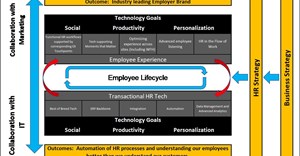Trending
 5 key moments that are solidifying Tyla's brandKarabo Ledwaba
5 key moments that are solidifying Tyla's brandKarabo Ledwaba George collapse rescue mission continues: 7 dead and 36 retrievedShafiek Tassiem and Esa Alexander
George collapse rescue mission continues: 7 dead and 36 retrievedShafiek Tassiem and Esa Alexander
 How Fica will affect dealers of high-value goodsHawken McEwan
How Fica will affect dealers of high-value goodsHawken McEwan
 Samsung goes back to competitive roots with A-seriesLindsey Schutters
Samsung goes back to competitive roots with A-seriesLindsey Schutters
Elections 2024
Jobs
- Sales Agent Cape Town
- Contract Assessors Remote
- Onboarding Manager Cape Town
Moving people analytics from HR to the C-suite

With increased focus on HR-related issues, including employee diversity, the gender pay gap, skills gaps, labour retention rates and employees’ role in the company’s cyber security, the C-suite now understands that people analytics is a vital part of running a high performing company. Finding the right data amongst people analytics results is the next step in utilising it to grow the business.
People analytics in action
According to Deloitte’s latest Global Human Capital Trends report, over two thirds (69%) of organisations are building integrated systems to analyse worker-related data, and nearly a fifth (17%) already have real-time dashboards to crunch the avalanche of numbers in new and useful ways.
Companies have an ever-widening pool of data to extract insight from. When asked about the sources they use, companies listed social media (17%), surveys (76%), and integrated data from HR and financial systems (87%). Should they want to, companies can dig much deeper into their employees’ psyche. Software that reads email and identifies the “mood” or “changes in mood” in team or organisational communication is now readily available.
Utilising people analytics
Nearly all companies seem to have people analytics high on their list of priorities. Per Deloitte’s report, the majority (71%) view organisational insights as a high priority, and nearly a third (31%) view it as very important. But viewing it as a priority and putting processes into action are two very different things.
The number of companies that are actually undertaking performance analytics and using enterprise scorecards has seen little year-on-year change. Only 8% report having enough usable data, 9% indicate comprehension of how talent dimensions relate to operational performance and as little as 15% use HR and talent scorecards for line managers.
For most companies, the idea of sophisticated, organisation-wide people analytics is working only in theory – not in practice.
How to benefit from people analytics
Heavy reliance on outdated legacy software makes it difficult to provide truly accessible data to share across the company. In our experience, lots of companies are still using Excel spreadsheets, which make it even harder to share up-to-date information: each department may have its own processes for inputting data even if these documents are shared between teams. This creates many versions of the same document with different additions.
This is where cloud-based analytics software really comes into its own. You can gather and interpret information in an instant – and invite your colleagues to work together on one set of data that is updated in real time. By making it easier to secure key data and insights relating to engagement, leave balances, training, terminations, and anything else you might need, your company can be kept up to date with real time information on HR processes. This means problems can be avoided and solved quicker, with better decisions made for the future.
To get the most out of people analytics, your company needs a modern attitude to data and modern tools in order to execute the process properly. By ensuring your business has smart people analytics, you can be sure you’ll be making smarter decisions – both for your employees and your company as a whole.













